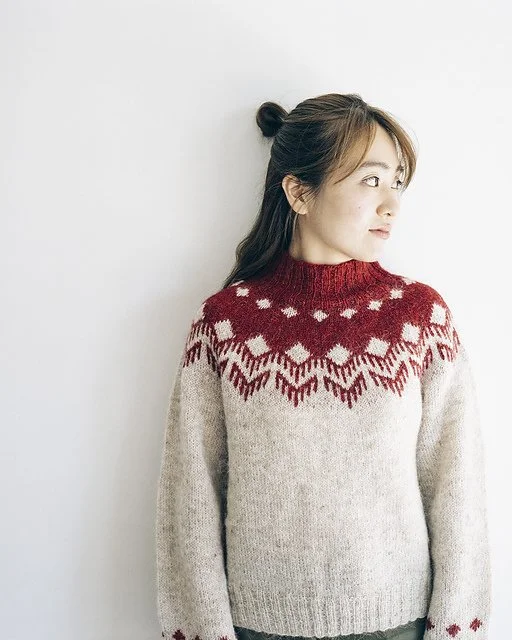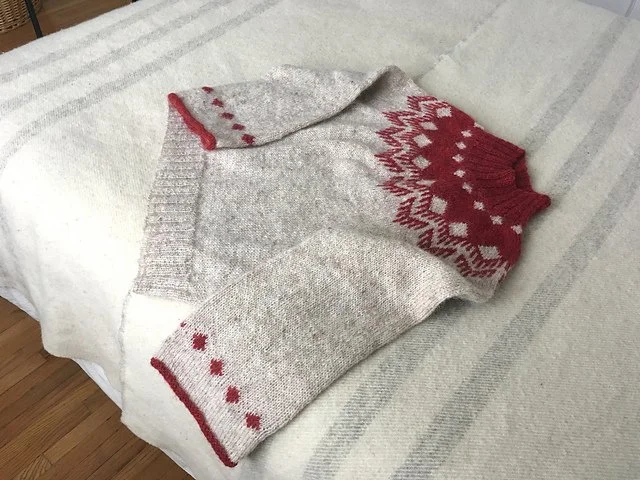Wetherell
or purchase through Ravelry.
Originally published in Amirisu #19. Wetherell is a cozy yoke sweater with wide sleeves, that is worked from the bottom up. It’s knit with a single strand of Istex Plotulopi, which creates a very warm, yet exceptionally light fabric. This pattern comes as a two file download. You will receive both the English and Japanese versions.
SIZES
XS (S, M, L, XL, 2XL, 3XL)
Finished bust measurements: 38 (411⁄4, 441⁄2, 491⁄2, 53, 58, 611⁄2)” / 96 (105, 113, 126, 135, 147, 156) cm
The sample is in size S on a 5’ 1” / 154 cm tall model with 9 3⁄4” / 25 cm positive ease at bust.
MATERIALS
Recommended Yarn
Istex Plotulopi (100% wool; 328 yards / 300 m, 100g)
Sample is shown in (MC) 0003 Light Beige Heather 3 (3, 3, 4, 4, 4, 4) plates, (CC) 1430 Carmine Red Heather 1 plate
(MC) Approximately 770 (860, 970, 1030, 1150, 1215, 1310) yards / 705 (785, 885, 940, 1055, 1110, 1200) m
(CC) Approximately 165 (185, 210, 220, 245, 260, 285) yards / 150 (170, 190, 205, 225, 240, 260) m
Needles
A US 6 (4.0 mm) 32” / 80 cm (or longer for larger sizes) circular needle
A US 6 (4.0 mm) needle in preferred style for working small circumferences (Double pointed needles, magic loop, short length circular needle)
A US 4 (3.5 mm) 16” / 40 cm needle in preferred style for working small circumferences (Double pointed needles, magic loop, short length circular needle)
A US 4 (3.5 mm) 32” / 80 cm (or longer for larger sizes) circular needle Or needles required to obtain gauge
Notions
Markers (4)
Tapestry needle
Stitch holders or waste yarn
GAUGE
19 stitches & 26 rounds = 4” / 10 cm in St st with US 6 (4.0 mm) needle
21 stitches & 34 rounds = 4” / 10 cm in 2x2 ribbing with US 4 (3.5 mm) needle
NOTES
Pullover is worked with a single strand of Plotulopi from the bottom up in the round, and the body and sleeves are joined at the underarms. The yoke is shaped first by working short rows at the back for a better fit around the neckline, then with raglan style decreases, followed by a colour work chart incorporating decreases. Change to a shorter circular needle or use the magic loop method when necessary as the yoke is decreased to neckline. The sleeves can be worked using the magic loop method, DPNs, or a short circular needle for the larger sizes.
Plotulopi yarn is fragile and should be handled gently and worked with a loose tension. However, once knitted it creates a lightweight, warm and strong fabric. It is recommended that yarn is worked from the plate centre, and care is taken to ensure it can be pulled freely. If yarn does tear while working with it, simply overlap ends and roll in hands to rejoin. Because of Plotulopi’s fragility, underarms are bound off and then seamed rather than grafted.
When working the stranded colour work, keep floats in the back loose to maintain fabric elasticity. This design has some very long floats! It is recommended to twist yarns together in back of work for floats longer than about 5 stitches.
Photos courtesy of Amirisu/ Masahiro Shimazaki




